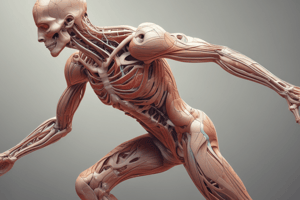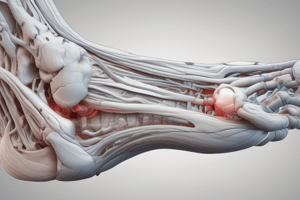Podcast
Questions and Answers
What primarily distinguishes biomechanics from general physiology?
What primarily distinguishes biomechanics from general physiology?
- Focus on chemical processes in the body
- Application of engineering principles to body movements (correct)
- Study of cellular structures and functions
- Exclusively concerned with muscle regeneration
Which of the following terms is least related to the study of kinematics in biomechanics?
Which of the following terms is least related to the study of kinematics in biomechanics?
- Angular extent
- Speed of movement
- Joint pressures (correct)
- Distances moved
The study of biomechanics mostly considers which of the following components?
The study of biomechanics mostly considers which of the following components?
- Chemical signals in muscle contractions
- Neural control of movement
- Mechanical descriptions of animal movement (correct)
- Genetics of muscle formation
Which aspect is NOT typically measured in kinetic studies within biomechanics?
Which aspect is NOT typically measured in kinetic studies within biomechanics?
In relation to biomechanics, which factor does NOT affect the movement about joints?
In relation to biomechanics, which factor does NOT affect the movement about joints?
Which factor is critical in understanding the design of prosthetics developed post WW2?
Which factor is critical in understanding the design of prosthetics developed post WW2?
What equation represents the force experienced by an animal when standing?
What equation represents the force experienced by an animal when standing?
What is a key feature of the knee joint that contributes to its function?
What is a key feature of the knee joint that contributes to its function?
Which type of joint movement is exhibited by the elbow?
Which type of joint movement is exhibited by the elbow?
How are angles at joints typically measured?
How are angles at joints typically measured?
Flashcards
Biomechanics
Biomechanics
The study of movement and forces acting on the body, focusing on how these impact joints and tissues.
Stress Resistance
Stress Resistance
The ability of a material to withstand stress without breaking or deforming. In biomechanics, it refers to the strength of bones and tissues.
Shape and Force Distribution
Shape and Force Distribution
The shape of bones can help to distribute forces more evenly, reducing the stress on joints.
Kinematics
Kinematics
Signup and view all the flashcards
Goniometer
Goniometer
Signup and view all the flashcards
Kinesiology
Kinesiology
Signup and view all the flashcards
Biomechanics in Physiology
Biomechanics in Physiology
Signup and view all the flashcards
Study Notes
Musculoskeletal Physiology - Biomechanics
- Course: BIOS 3100
- Academic Year: AHW 2024
Introduction
- Biomechanics applies engineering principles to describe animal movements, specifically human physiology (kinesiology).
- Biomechanics considers the cardiovascular system but primarily focuses on movements around joints.
- Movements can be described by angular extent, distance, speed and force.
Measuring Movements (Kinematics)
- Kinematics examines movement about joints.
- Key types of movement include: hinge (knee), ball and socket (hip/shoulder), rotational pivot (elbow), saddle (thumb), mortise & tenon (ankle).
- Angles are measured with goniometers (angle meters), usually perpendicular to the resting plane.
- Levers are also part of kinematic analysis. There are three main types: first-class (fulcrum between force and load), second-class (load between force and fulcrum), and third-class (force between load and fulcrum).
Measuring Force & Speed (Kinetics)
- Kinetics deals with force and speed in musculoskeletal movement.
- Kinetics includes force generation by muscles.
- Foot and ground reaction forces are also studied in kinetics.
- Joint pressures during movements are also investigated.
- Forces are measured in Newtons, and lengths in meters.
- Mechanical advantage (MA) is a factor of lever and load arm lengths from the fulcrum (MA = Lever arm/Load arm).
Shape and Forces
- Joint shapes influence force distribution (force per unit area).
- Larger ends of long bones enhance stability, reducing force impact.
- Knee structure (rounded femoral condyles and flattened tibial condyles) is the largest joint.
Isotonic Shortening
- Isotonic shortening of the biceps brachii (a type 3 lever) is rapid and extensive movement, with mechanical advantage less than 1.
Importance in Medicine/Sports
- Biomechanics is useful in medicine and sports training.
- Quantitative descriptions of movements are useful in evaluating posture, injury risks, and exercise effectiveness.
- Assessing forces help with developing prosthetics, rehabilitative protocols, or optimizing athletic performance.
Summary
- Biomechanics incorporates kinematic (movement) and kinetic (force and energy of movement) aspects to describe human movement reductively.
- Numerous studies of gait and other human movements are available (academic and clinical).
- Levers are a useful model for joint action.
Studying That Suits You
Use AI to generate personalized quizzes and flashcards to suit your learning preferences.
Related Documents
Description
Explore the biomechanics of human movements in the BIOS 3100 course. This quiz covers the principles of kinematics and kinetics, focusing on joint movements and the forces involved. Test your understanding of muscle function and mechanical principles applied to human physiology.




